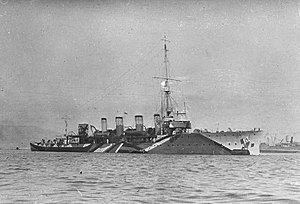Name HMS Adventure Commissioned October 1905 Construction started 7 January 1904 Draft 3.78 m | Laid down 7 January 1904 Decommissioned 12 August 1919 Launched 8 September 1904 | |
 | ||
Fate Sold for scrap, 3 March 1920 Class and type Adventure-class scout cruiser | ||
HMS Adventure was the name ship of her class of scout cruiser built for the Royal Navy during the first decade of the 20th century.
Contents
Design and description
The Adventure-class ships were one of four classes of scout cruisers ordered by the Admiralty. These ships were intended to work with destroyer flotillas, leading their torpedo attacks and backing them up when attacked by other destroyers, although they quickly became less useful as destroyer speeds increased before the First World War. Adventure had a length between perpendiculars of 374 feet (114.0 m), a beam of 38 feet 3 inches (11.7 m) and a draught of 12 feet 5 inches (3.8 m). She displaced 2,670 long tons (2,713 t) at normal load and 2,893 long tons (2,939 t) at deep load. Her crew consisted of 289 officers and other ranks.
The ship was powered by a pair of three-cylinder triple-expansion steam engines, each driving one shaft, using steam provided by a dozen Yarrow boilers. The engines were designed to produce a total of 16,000 indicated horsepower (12,000 kW) which was intended to give a maximum speed of 25 knots (46 km/h; 29 mph).
The main armament of the Adventure class consisted of ten quick-firing (QF) 12-pounder 18-cwt guns. Three guns were mounted abreast on the forecastle and the quarterdeck, with the remaining four guns positioned port and starboard amidships. They also carried eight 3-pounder Hotchkiss guns and two submerged 18-inch (450 mm) torpedo tubes. The ships' protective deck armour ranged in thickness from .75 to 2 inches (19 to 51 mm) and the conning tower had armour 3 inches (76 mm) inches thick.
Construction and career
Adventure was laid down by Armstrong Whitworth at their shipyard in Elswick on 7 January 1904, launched on 8 September and completed in October 1905. Her original name was going to be Eddystone, but this was changed before construction began. Not long after completion, two additional 12-pounder guns were added and the 3-pounder guns were replaced with six QF 6-pounder Hotchkiss guns. In April 1907, Adventure collided with, and sank, a sailing boat off the Sussex coast. She was commissioned in June of that same year as the leader of the 1st Torpedo Boat Destroyer Flotilla and was refitted at Chatham Royal Dockyard in June 1910. She then became flotilla leader for the 2nd Destroyer Flotilla based in Devonport. She underwent another refit in August 1912, about which time her main guns were replaced by nine 4-inch (102 mm) guns, and then joined the 3rd Light Cruiser Squadron for the 1913 fleet manoeuvers. In July 1913, Adventure joined the 6th Destroyer Flotilla based at Dover.
In May 1915 she joined the 6th Light Cruiser squadron on the Humber to patrol against Zeppelins raiding up the east coast. In July of that year became the flagship at Queenstown until November 1917. On Boxing Day in 1915 she distinguished herself by rescuing the crew of the stricken steamship Huronian. She escorted convoys to Gibraltar during the last summer of the war, then served in the Mediterranean and, in 1919, the Aegean. She returned to Immingham docks to be paid off on 12 August 1919. Her bad luck with collisions continued when she was rammed by a trawler on the Humber in January 1920. She was then sold to the breakers for scrap on 3 March 1920 and was towed by fellow scout cruiser Skirmisher to Morecambe.
